Posters of the Second World War – An Analysis
         -What was the impact of the posters from the Second World War?
         -Why are they still popular?
Introduction:
For my dissertation I have chosen to look at the posters from the Second World War. The idea to look at these posters came from my own interest in the war, the 1940’s and the ‘propaganda’ posters. I wanted to look further into them; why they were created, and what for?, did the posters do anything to help people during the war? And how/ why they still remain so popular today? After researching the era, researching the posters and visiting various places I decided I wanted to look at how people acted upon these posters and how they all helped with the war effort.
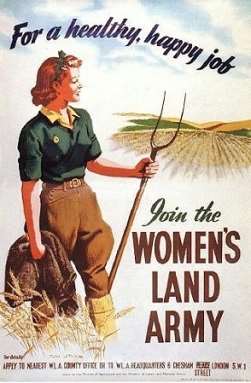 Life changed massively from the moment it was announced Britain was at war – Everything was rationed from food to petrol, gas masks were issued, children had the option to be evacuated, men were going to war and women were working. Even though there was so much going on and your normal day to day life could change at any moment the government wanted to try and get people to work and live as normally as they possibly could. The government was issuing hundreds of posters; urging people to work for victory, reminding you to wear your gas masks, talk less, turn off the lights, walk to work, plant vegetable, health posters and so many more. I wanted to look into these posters and how they helped people throughout the war and if they did help at all. There was so many posters produced, some of the posters I wanted to look at are: ‘Keep Calm and Carry on’, ‘Dig for Victory’, ‘Make do and mend’, ‘Don’t do it, mother – leave the children where they are’ and a few more.
Life changed massively from the moment it was announced Britain was at war – Everything was rationed from food to petrol, gas masks were issued, children had the option to be evacuated, men were going to war and women were working. Even though there was so much going on and your normal day to day life could change at any moment the government wanted to try and get people to work and live as normally as they possibly could. The government was issuing hundreds of posters; urging people to work for victory, reminding you to wear your gas masks, talk less, turn off the lights, walk to work, plant vegetable, health posters and so many more. I wanted to look into these posters and how they helped people throughout the war and if they did help at all. There was so many posters produced, some of the posters I wanted to look at are: ‘Keep Calm and Carry on’, ‘Dig for Victory’, ‘Make do and mend’, ‘Don’t do it, mother – leave the children where they are’ and a few more.
 One of the many things of the war I have always found interesting and is something I wanted to look at within this dissertation is family life – ‘Evacuation’ and the ‘make do and mend’. Evacuation of the war was one of the greatest movement and decisions made by the government during the war – over 3,500,000 children were taken away from their homes to avoid the bombings and move out to the country and smaller areas less likely to be attacked. The first big attack on London lasted up to 76 days and nights, thousands were killed, injured and made homeless: The homeless resulted to camping nearby and thousands of people slept on the platforms of the underground stations each night. The main places were evacuation was taking place were on large cities such as London, Manchester, Liverpool, Portsmouth, Southampton, Bristol and Glasgow. Even though evacuation was an optional thing to do the government tried to push it as much as possible so children were safe and out of the way. After a while nothing was happening and parents felt that their children had been sent away for no reason, the government produced hundred more posters to try and explain that this wasn’t the case. I wanted to look more into these posters to find out when these posters started to go out to the public, what the reaction was and if they did work like they hoped.
One of the many things of the war I have always found interesting and is something I wanted to look at within this dissertation is family life – ‘Evacuation’ and the ‘make do and mend’. Evacuation of the war was one of the greatest movement and decisions made by the government during the war – over 3,500,000 children were taken away from their homes to avoid the bombings and move out to the country and smaller areas less likely to be attacked. The first big attack on London lasted up to 76 days and nights, thousands were killed, injured and made homeless: The homeless resulted to camping nearby and thousands of people slept on the platforms of the underground stations each night. The main places were evacuation was taking place were on large cities such as London, Manchester, Liverpool, Portsmouth, Southampton, Bristol and Glasgow. Even though evacuation was an optional thing to do the government tried to push it as much as possible so children were safe and out of the way. After a while nothing was happening and parents felt that their children had been sent away for no reason, the government produced hundred more posters to try and explain that this wasn’t the case. I wanted to look more into these posters to find out when these posters started to go out to the public, what the reaction was and if they did work like they hoped.
Chapter One: The Second World War
                        Why were these posters produced?
                        Did they do anything?
Chapter Two: Keep Calm and Carry On
                        Why has this poster become so iconic?
Chapter Three: Imitations and Popularity
                          Why are these posters still so popular?
                          How have they been reused?
Chapter One:
The Second World War
    – Why were the posters produced?
    – Did they do anything?
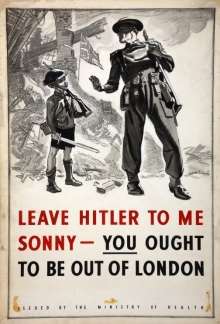 Before the war officially broke out the government tried everything to prepare Britain for what was to come. Posters were one of the main ways to get the message across to the general public, which means these posters would have been seen everywhere. So many posters were produced during the second world war informing the general public on everything; Appeals and instructions, Immunization against Diphtheria, preventing the spread of a common cold, women covering their hair in factories, ‘Dig for Victory’ and so many more. The earliest poster produced by the Ministry of Information was ‘your courage, Your Cheerfulness, Your resolution will bring us victory’ – which was one of three in a series of posters produced in 1939.
Before the war officially broke out the government tried everything to prepare Britain for what was to come. Posters were one of the main ways to get the message across to the general public, which means these posters would have been seen everywhere. So many posters were produced during the second world war informing the general public on everything; Appeals and instructions, Immunization against Diphtheria, preventing the spread of a common cold, women covering their hair in factories, ‘Dig for Victory’ and so many more. The earliest poster produced by the Ministry of Information was ‘your courage, Your Cheerfulness, Your resolution will bring us victory’ – which was one of three in a series of posters produced in 1939.
 Evacuation:
Evacuation:
Evacuation began on 1st September 1939 inn major cities such as London, Manchester, Belfast and Liverpool. The government wanted the children out of the way before the attacks started, it was expected that the war would open with a massive aerial attack on British cities. The government designed came up with the idea to protect people in Britain but particularly children by moving them to areas thought to be less at risk. School children (827,000) and their teachers, Mothers with children under 5 (524,000), Pregnant women (12,000) were evacuated. There were many posters produced by the government for the idea of evacuation; ‘Mothers send them out of London’ -even though evacuation was voluntary the government tried to urge women to register their children for evacuation to protect them from what was to come and they would be safer from the bombs in the country.
Evacuees returned home January 1940; The period known as the ‘Phoney War’, no real danger was happening and a lot of people felt cheated that they had sent their children away for no visible reason. Efforts were made to persuade parents that it was their patriotic duty to send their children back to the country. With children returning home the Ministry of Health produced more posters warning mothers not to be tempted by Hitler and the non- events that have happened; ‘DON’T do it mother – LEAVE THE CHILDREN WHERE THEY ARE’. Many of the posters produced at this time for evacuation were talking to the mothers trying to persuade them to ‘leave the children where they are’ – where they are the safest. This particular poster is one of the most recognised; it portrays a mother and her two children with a ‘ghostly’ figure of Hitler saying ‘take them back! Take them back! Take them back!’. The design of the poster is very simple with a hand drawn black and white image with the text being the main focus highlighted in red.
The one downside to the evacuation at first was not everyone was keen to take the children in but for some they did go and live with family or family friends. ‘It might be you! Caring for evacuees is a national service’ – These posters were produced to remind people of their duty to help with the war efforts by taking in the homeless from the cities.
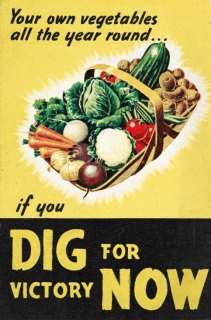 Dig for Victory
Dig for Victory
Rationing began 8th January 1940 just months after the Second World War broke out. The ‘Dig for Victory’ campaign was set up during the Second World War by the Ministry of Agriculture; the idea was to encourage men and women to grow their own food to help with the war effort. Many open spaces were turned into allotments; a garden, public parks – even the lawn outside the tower of London was turned into a vegetable patch. Before rationing and the Dig for Victory campaign was introduced Britain was reliant on the cheap imports of food from overseas; main suppliers were from Canada and America.
 Everyone had to help with the effort: Men, women and children – everyone could do their bit whether it was looking after an allotment or growing vegetables in the garden or window box. The Dig for Victory campaign seemed to be successful with getting the ‘help with the war effort’ message across. It became a part of children’s everyday school routine – all children helped digging by going to the parks in the afternoon to dig up carrots, cabbages and potatoes. By 1943 there were over 1.4million allotments producing over a million tons of vegetables that year.
Everyone had to help with the effort: Men, women and children – everyone could do their bit whether it was looking after an allotment or growing vegetables in the garden or window box. The Dig for Victory campaign seemed to be successful with getting the ‘help with the war effort’ message across. It became a part of children’s everyday school routine – all children helped digging by going to the parks in the afternoon to dig up carrots, cabbages and potatoes. By 1943 there were over 1.4million allotments producing over a million tons of vegetables that year.
Two very iconic posters are ‘Your own vegetables all the year round if you dig for victory now’ and ‘Dig for Victory’ they both have two very different designs with the same messages. Out of the both of these posters the most iconic and recognisable is the poster of the young boy with his back to you while his walks off to contribute to the war effort. This has such a basic design and colour pallet but with a clear ‘Dig for Victory message. The other however is similar to the evacuation poster, the main focus of the poster is not meant to be the imagery but it is the text. This has been highlighted in yellow and black along with a large font to grab your attention.
There were many posters produced for the Dig for Victory campaign and others by the Ministry of Health. The Ministry created cartoon characters such as ‘Potato Pete’ and ‘Doctor Carrot’, the idea was to show how good these vegetables were for you. Slogans read: ‘I’m a protective food’- says Potato Pete’, ‘Call me often and you’ll keep well’ – Doctor Carrot’. These adverts/ posters proved successful and were popular amongst children as they both had songs to go alongside them as well as recipe books for the parents.
‘Dig for Victory, grow your own vegetables now’, ‘your own vegetables all the year round…if you DIG FOR VICTORY NOW!’ a lot of posters produced showed more women working than they did men at this time; As a lot of the men went to war it was the women’s job to fill in and do the jobs the men had left behind. Rather than showing young women in elegant dresses, magazines and posters showed happy young women with pitch forks helping the war effort. Without these posters persuading and showing the women doing men’s jobs (factory, farming, Mechanics) the jobs for women wouldn’t have progressed like they have done and they would still be expected to be housewives.
The Dig for Victory campaign proved to be one of the most successful from the Second World War. The idea of growing your own food didn’t just stop straight after the war had ended, it continued for many years after and people are still doing it now.
Both of these posters proved to be a huge success during the Second World War, the general public acted upon them and chose to do the right thing to help with the war effort. The posters changed the way the UK lived and worked for many years after and they still have an effect on what we do today.
Chapter Two:
Keep Calm and Carry On
    -Why has this poster become so iconic?
The message ‘Keep Calm and Carry on’ nowadays has been completely taken out of context and is seen everywhere; posters advertising events (pub quiz), used online (‘Memes’ – ‘Keep calm and go to Hogwarts’), Companies are using the slogan and has appeared on Homeware and so much more.
But why do people still love this message?
The poster was originally produced by the Ministry of Information in 1939 after the outbreak of the Second World War. The Ministry of Information designed three morale boosting posters which were to be displayed across Britain. They read; ‘Your Courage, Your Cheerfulness, Your Resolution will Bring us Victory’, ‘Freedom is in Peril, Defend it with all your might’ and ‘Keep Calm and Carry On’. Two out of the three posters were seen on public transport, in shop windows, on notice boards and many other places across Britain. The Ministry of Information produced hundreds of posters during the war to spread important messages. During the war the main way of reaching people was through billboards, public transport and in papers – during the 1940s people weren’t trying to compete with television, internet and social media.
The ‘Keep Calm and Carry on’ poster was rediscovered in 2000 at Barter Books in Alnwick, Northumberland. The owner of the shop found the poster folded up at the bottom of a box of books. After the poster was found it was framed and hung in the shop – It attracted so much interest that the owners began to produce and sell copies. Later this turned into more products and then soon after other people copied the ‘keep calm’ and products with this slogan were seen everywhere.
The plan for the ‘Keep Calm’ poster was to only issue it on the invasion of Germany – This didn’t happen which meant the poster was never officially seen by the public. Over two-and-a-half-million copies were printed to be distributed across Britain. The ‘Keep Calm’ poster is one of the many few during the war that wasn’t telling people to go out and fight, dig for victory, made do and mend as well as ‘careless talk’. This particular poster was just a simple message telling people to remain calm during the situation and not to panic.
“The poster is now seen not only as a distillation of a crucial moment in
  Britishness, but also as an inspiring message from the past to the present
in a time of crisis” – Susannah Walker-Design Historian
I agree with the previous statement, people admire many posters from the second world war for many reasons; some of the posters are still relatable, bring back memories and have stories to tell. However ‘Keep Calm and Carry On’ – it is one of the most well-known posters from the war which was never used. People nowadays still like this poster as it is a nostalgic memory from the war but when the series of posters were released people didn’t like them;Â the people who saw the posters said they were patronising and divisive. The entire campaign produced by the Ministry of Information was completely scrapped just after four weeks. The posters they had printed were stored away and kept until April 1940, The majority of the posters were pulped as part of the governments idea to recycle paper so only a few copies survived.
 With its rising popularity over the years it has become one of the iconic images of the 21st century, not just from the original design but from everything that has come from this one image.Â
With its rising popularity over the years it has become one of the iconic images of the 21st century, not just from the original design but from everything that has come from this one image.Â
The popularity of the poster spreads further than just Britain; it has been spotted in ‘seaside’ town gift shops in America. When it reaches places like this the poster ends up losing its ‘Britishness’ and becomes a very ‘stereotypical’ thing about the country.
 Why is it hated?
Why is it hated?
People like the original postern for how British it is as well as it having a sense of nostalgia and memories of the war as well as the message behind the poster; it is also hated by what has become of it and how it is constantly adapted online. Online was the first place where the poster began to go away from the original message; ‘Keep Calm and Call Batman’, ‘Keep Calm and Hakuna Matata’, ‘Keep Calm and Eat a cupcake’ and so many more. Soon after the adapted versions were seen on mugs, notebooks, being used to advertise products – People wanted to see the end of the poster after this.
But why do we as a country still love and cling onto this poster?
Realistically with the ‘Keep calm and carry on’ poster people want to hate it (some do) and wish it would die of death like many other ‘trends’ over the years, many people however secretly do like it.
In the UK we are drawn instantly to anything baring the flag, Royal Family, Tea and all the normal ‘stereotypical’ British things. It is the same with this poster; people are drawn to the Britishness of it and the calming yet nostalgic message. It is one of the many posters from the Second World War that at times can still relate to any issue going on in our country. It still spreads the same message to us now as it should have done then.
Comparing the current government to the government then it would be difficult for them now to come up with a poster that has the same appeal to it – powerful and simplicity might not be enough these days. Posters produced by the government now attempt to convince the public of a danger and get them to modify their behaviour; ‘Keep Calm and Carry On’ tells you to think another way and continue acting as you have always acted. There would be attempts to create new and improved posters or even try and develop ones that already exist. If anything were ever happen to the United Kingdom like it did during the war, people would go back and dig out the old posters. They worked before, they will work again.
Chapter Three:
Imitations and Popularity
     – Why are these posters still so popular?
     – How have they been re-used?
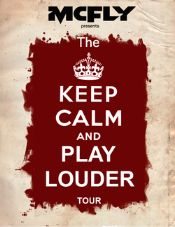 Many of the posters from the Second World War are always being imitated; if it’s to advertise new products of to promote a local event. These posters are always coming back around just designed in a different way; one of the easiest posters to re-produce is ‘Keep Calm and Carry On’.
Many of the posters from the Second World War are always being imitated; if it’s to advertise new products of to promote a local event. These posters are always coming back around just designed in a different way; one of the easiest posters to re-produce is ‘Keep Calm and Carry On’.

 Keep Calm and Carry On
Keep Calm and Carry On
In 2012 McFly promoted their tour called ‘The Keep Calm and Play Louder tour’ -Â the design of the poster was kept the same with the red background and the grown of King George but with the bands logo added to the image. Another company to use the ‘Keep Calm’ was Nectar in 2010 to promote the loyalty card; ‘Keep Calm and Carry One’. The campaign was featured in over nine newspapers including; The Sun, Daily Mirror, Metro, The Times and The Telegraph. The design of the poster was kept similar to the original with the layout and text – The background was the Nectar ‘purple’ and in place of the crown was the nectar card.
In 2012, Shepheard Neame released limited edition bottles; ‘Keep Calm and Celebrate’. The idea behind the bottle was to evoke on the country-wide pride during the summer of national celebration; London Olympics, Diamond Jubilee and Euro 2012 as well as to commemorate the Battle of Britain – The bottles were only issued at large events. The design of the ‘Keep Calm’ was kept simple – background changed to navy and in place of the crown was a spitfire.

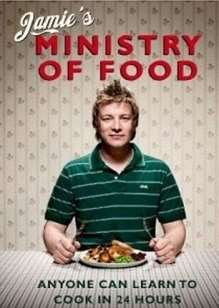 Ministry of Food
Ministry of Food
It isn’t just the posters that are always being imitated and reproduced, it’s even sayings and old campaigns. Back in 2008, Jamie Oliver released a book and TV series called ‘Ministry of Food’ – This has been taken from the food rationing system from the war.
What was the Ministry of Food during world war two?
During the Second World War the ‘Ministry of food’ was more known as ‘Minister of food’ and ‘Minister of food control’. The main task for the Minister of Food during the war was to oversee the rationing in the UK; originally the idea of rationing began as an experiment and for the ministry it worked surprisingly well. Rationing officially began in early January 1940 and was a major success of the Second World War. With the food supplies cut short because of Germany’s actions and the needs of the services, rationing was an essential and by 1942 most foods were rationed. One issue the Minister of food had with the rationing was children – they wanted to make sure that Britain was providing 650,000 children with free school meals and to guarantee them an adequate nutrition (for everyone not just the children). The minister of food released recipes to help people through the war to create simple and easy meals with the little food they had. Jamie Oliver TV program and book idea was an aim to try and recreate the success of the ministry of food and try and encourage healthy eating. From this program he set up four ‘Ministry of food centres’ which were all offering the food he had been producing on the show. The title of the show is a play on the ‘Ministry of food’ and ‘Minister of food’.
 Make do and mend
Make do and mend
‘Make do and mend’ isn’t a poster that people are taking off but it is still something a lot of people do still follow. You could argue that we now live in a ‘throw-away society’ when our clothes get stained or the seams of trousers show any wear we simply dispose of the item or rebuy them as clothing has become cheaper. There are however a lot of younger people who prefer to upcycle clothes or even make their own from rummaging through a charity shop.
The ‘Make do and mend’ campaign started when clothes rationing was introduced during the Second World War. The Ministry of information produced a pamphlet encouraging people to do whatever they could to extend the life of their clothes (a leaflet which is still reproduced and sold in some museum gift shops). The campaign played an important part in  the daily life during world war two. The shortage of clothes
the daily life during world war two. The shortage of clothes 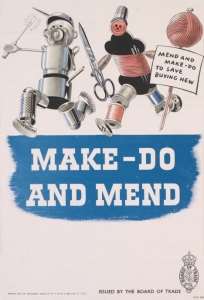 was down to sinking ships coming into England as well as the clothing manufacturers were commissioned to manufacture uniforms as a priority. As clothing was now a shortage, in 1941 clothes rationing was introduced: people were given 66 coupons a year (which was later reduced) a woman’s blouse was 12 coupons, 11 coupons for a dress, 2 for socks/stockings, 8 for a men’s shirt or trousers, 5 for women’s shoes and 7 for men and extra coupons were given to children. As everything was being rationed clothes had to last a lot longer so people began to make new clothes from the old and from any other household linen. Nothing was thrown away, especially if it could be made into something else.
was down to sinking ships coming into England as well as the clothing manufacturers were commissioned to manufacture uniforms as a priority. As clothing was now a shortage, in 1941 clothes rationing was introduced: people were given 66 coupons a year (which was later reduced) a woman’s blouse was 12 coupons, 11 coupons for a dress, 2 for socks/stockings, 8 for a men’s shirt or trousers, 5 for women’s shoes and 7 for men and extra coupons were given to children. As everything was being rationed clothes had to last a lot longer so people began to make new clothes from the old and from any other household linen. Nothing was thrown away, especially if it could be made into something else.
A pamphlet was part of the campaign and was intended to provide housewives with useful tips and ideas on how to reuse old clothing. Readers were advised to create: decorative patches to cover holes on warn garments, unpick old jumpers to re-knit alternatives and turn men’s clothing into women’s. One of the hardest things for parents with the clothing ration was struggling to clothe their growing children – Clothing Exchanges were set up by the women’s voluntary service to help meet these parent’s needs. Parents could take clothes their children had outgrown and swap it for new clothes. Like I mentioned previously a lot of people do enjoy Sewing, knitting, crochet and making their own clothes and it is still a popular thing to do. I think that the make do a mend campaign is still applies now and people do still follow the ideas and information inside the pamphlet like people did then.
Within this dissertation the one poster I wanted to look at more so than the others was ‘Keep Calm and Carry On’. It is the most overused poster from the 1940s and has slowly become one people can’t stand. The meaning behind the poster has been lost and taken out of context, from the way it is used online through ‘memes’ to the way companies are using it to advertise products. I have discovered that a lot of the hate towards the poster has come from online and how it became adapted and stepped away from the original message; ‘Keep calm and go to Hogwarts’, ‘Keep calm and call the doctor’, ‘Keep calm and let it go’ and so many more. The adapted versions are seen everywhere. In conclusion to this I have found out that the posters from the Second World War will always have a strong impact on Britain – There was throughout the war and they have had a similar impact for many years after. These posters will always remain popular; we are drawn to them regardless if it is the original posters or something that has been created from the original. Posters such as ‘Dig for victory’ is still a poster that is followed today with people still growing their own vegetables, ‘Make do and mend’ is another poster which is still followed with people still making their own garments from scraps and new fabrics.
Bibliography:
Waller, Maureen (2012) A family in wartime: How the Second World War shaped the live of a generation: Conway
Pages: 10,16,20,47,72,121,125
Williams, Brenda (2006) The World at War – World War II: The Homefront: Oxford
Ross, Stewart (2007) At home in World War Two: Evacuation : Evans Brothers ltd
First News and The Silverline (2016) Voices from the Second World War: Witnesses share their stories with the children of today: London – Walker Books and Subsidiaries
The Story of Keep Calm and Carry on (Uploaded: Barter Books – 28th February 2012)
https://www.youtube.com/watch?v=FrHkKXFRbCI
Dig for Victory (Uploaded: 20th March 2009) Imperial War Museum Collections
https://www.youtube.com/watch?v=H_Gs7Vik75k
Poison gas and gas masks : Join me in the 1900 [online] www.1900s.org.uk/1940s-gas.htm
Evacuation in World War Two (2013) [online] www.primaryhomeworkhelp.co.uk/war/evacuation1.html
The Evacuated Children of the Second World War : Imperial War Museum [online]
www.IWM.org.uk/history/the-evacuated-children-of-the-second-world-war
Evacuation – How it affected ordinary lives : Home sweet Home front (July 2011) [online]
www.homesweethomefront.co.uk/web_pages/hshf_evacuees_pg.htm
Dig for Victory: Home sweet Home front (July 2011) [online]
www.homesweethomefront.co.uk/web_pages/hshf_dig_for_victory_pg.htm
How ‘Dig for Victory’ campaign helped win the war – The Telegraph (April 2013) [online]
www.telegraph.co.uk/news/earth/environment/9996180/how-dig-for-victory-campaign-helped-win-the-war.html
How to Dig for Victory : The Big World [online] www.thebigworld.co.uk/howtodigforvictory.htm#.V87xNgrLiu
Keep Calm and Carry On [online] http://en.m.wikipedia.org/wiki/keep_calm_and_carry_on
‘Keep Calm and Carry on – the sinister message behind the slogan that seduced the nation’
The Guardian (January 2016) [online]
https://www.theguardian.com/books/2016/jan/08/keep-calm-and-carry-on-posters-austerity-abiquity-sinister-implications
Keep Calm and Carry On (2011) [online] www.knowyourmeme.com/memes/keep-calm-and-carry-on
‘I am the keep calm and carry on man’ – The Independent (April 2009) [online]
www.independent.co.uk/news/people/profiles/first-person-I-am-the-keep-calm-and-carry-on-man
Keep calm and carry on -History [online] www.keepcalmandcarryon.com/history/
How long can the ‘Keep calm’ trend carry on? The Independent (May 2015) [online]
www.independent.co.uk/news/uk/this-britain/how-long-can-the-keep-calm-trend-carry-on-8627557.html
The Greatest motivational poster ever? – BBC News (February 2009) [online] news.bbc.co.uk/1/hi/magazine/7869458.stm
Nectar ad plays on wartime poster for new era of post-budget austerity -The Guardian (June 2010) [online] http://www.theguardian.com/media/2010/Jun/22-nectar-loyalty-card-advert-keep-calm
Make do and mend – Victory living (2010) [online] www.victoryliving.co.uk/make-do-and-mend
Make do and mend -1943 -British Library [online] www.bl.uk/learning/timeline/item106365.html
8 facts about clothes rationing in Britain during the Second World War -Imperial War Museum [online] www.iwm.org.uk/history/8-facts-about-clothes-rationing-in-britain-during-the-second-world-war
Minister of food – Wikipedia http://en.wikipedia.org/wiki/minister_of_food_(united_kingdom)
Shepherd Neame produces limited edition spitfire bottle for 2012 events – Big Hospitality (march 2012) [online]
www.bighospitality.co.uk/new_products/shepherd_neame_produces_limited_edition_spitfire_bottle_for_2012_events